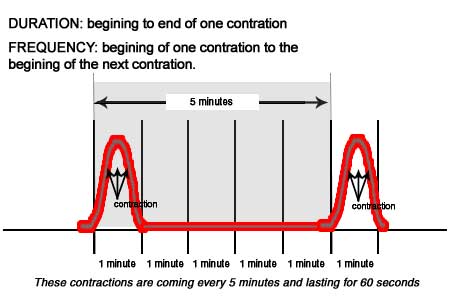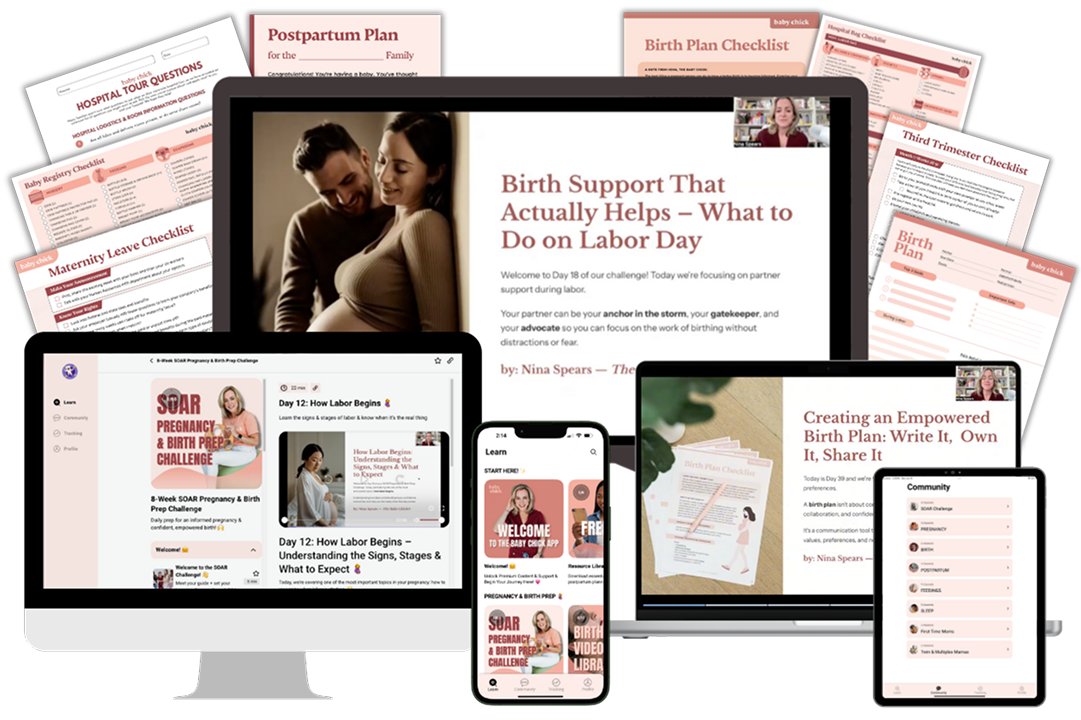Most dads don’t know what labor and childbirth will be like, except for what they’ve seen in the movies and TV shows. And in reality, they need to forget about all that! Having a baby from start to finish within 15 to 30 minutes (we wish!) is unrealistic. Labor can sometimes (very rarely) happen quickly, but it doesn’t most of the time. This is especially the case if she’s expecting her first baby.1 When labor and birth happen in real life, dads can feel overwhelmed and clueless about what to do and how to best help and support their partner when she needs it the most.
Several dads have asked me, “What are the top things I need to know to best support my partner during her labor and the birth of our baby?” So, I’ve come up with a list! I believe these are the best ways to support your partner through one of the biggest experiences of both your lives.
Dads During Labor: How To Best Support the Laboring Mother
Here are my seven tips for dads to help them be the perfect birth partner during labor:
1. Know What To Expect During Labor
One of the best ways to support your laboring partner is to know what to expect during labor. This will help you feel more empowered and knowledgeable about what’s happening. So, I highly recommend dads prepare for their baby’s birth by attending a childbirth class with their partner. All hospitals and birth centers hold classes, and — in most towns — several offsite classes are offered in each community. Be sure to look into all your options and talk to your partner about which class is best for both of you. Each type focuses on different topics and comfort techniques during labor. By taking a class or series of classes, you’ll learn what is and isn’t normal. You’ll also be able to help her every step of the way.
Note: I prefer and recommend nonhospital classes to my clients. This way, there are no restrictions on what the instructor can teach or how they can answer your questions. I’m not saying hospital classes aren’t good classes. I just prefer that my clients learn all the available options for each part of labor, what to expect, and what’s normal. I don’t want anyone demanding the instructor to leave out any information that could help you and your partner during her labor because it’s an “inconvenience” to the hospital or care provider.
2. Help Time Her Contractions
First, you don’t need to time her contractions when she starts feeling them. Once you both recognize that her contractions are consistent, getting closer together, and getting stronger, that’s a good time to start timing them. This will help you see how long and far apart they are.2
I always recommend my clients download a “contraction timer” app on their phones. There are plenty of free ones available. Getting an app makes timing and keeping track of your partner’s contractions so much easier. If you don’t have a smartphone, ensure your watch has a readable second hand and have a pen and paper to record the contractions. You will time your partner’s contractions from the beginning of one contraction to the beginning of the next. Count the frequency of each contraction in minutes.3

Dad Tip: If your partner has regular, intense contractions lasting 30 seconds or longer, she’s probably in early labor.4 Ensure that she gets enough rest during early labor so she has enough energy for active labor, transition labor, and pushing.
3. Don’t Go to the Hospital Too Early
I know it’s exciting when your partner announces she is having contractions! But please don’t rush to the hospital the minute she says she’s in labor. If you do, more than likely, her contractions aren’t frequent or strong enough, and her cervix probably hasn’t dilated enough to be admitted into labor and delivery. That means they will turn you both away, and you’ll have to return home.
To save yourself from making the trip several times, try not to watch the clock. Help your partner take her mind off the contractions. Again, you want to make sure she’s getting plenty of rest. She will need her energy for the rest of her labor and pushing. However, you can mix it with some activities while waiting for labor to start. Go for a walk, go to the mall or a museum, watch a movie, or bake cookies. Her nurses will love it if you bring them cookies! Do whatever your partner will enjoy to take her mind off labor without getting exhausted. Also, home is a much more comfortable place when she’s in labor. She can eat, drink, and walk around freely without being hooked up to an IV or monitors. She can also nap in her own bed, and so can you!
Here are a couple of other things to look out for before taking her to the hospital:
Contractions
Remember, as a general rule, if the contractions are five minutes apart or less, lasting one minute or longer, and continue in this pattern for at least an hour, you can go to the hospital.5 If her labor starts at night, help her get back to sleep for a few hours.6 Try rubbing her lower back and putting a warm compress/heating pad on her lower back. This can help relieve some of the pain.
Water Breaking
If her water breaks first, here’s a list of questions you need to ask her:
- “When your water broke, was it a gush of fluid or just a trickle?” This will let you know if it was a high tear (a trickle of water) or a low tear (big gush).7
- “Is the fluid clear, or is there a color to it?” If there’s a yellow, brown, or greenish color in the water, it means there’s meconium (baby’s first poop) in the water. This could mean that your baby is in distress since it’s already pooped inside.8,9
- “Does it have a distinct foul smell?” Not that the water/amniotic fluid is odorless, but it shouldn’t smell completely foul. If there’s a very distinct foul smell, it could be an infection.8
- “Do you still feel the baby moving?” This is the MOST critical question. If the water broke and there was a big gush, the umbilical cord could’ve slipped through the cervix (cord prolapse). This can cut off the oxygen and circulation to your baby.10 If she doesn’t feel the baby move as usual, drive immediately to the hospital if you live nearby or call 9-1-1.
Note: Water will continue to come out until the baby is born. So, don’t worry about it still leaking.11
If the color is clear, there’s no distinct smell, and she can feel the baby move, you have up to 12 hours to get to the hospital.12 However, if she isn’t feeling contractions after her water has broken, have her get up, go for a walk, sit on an exercise/birthing ball, do nipple stimulation, press on acupressure points, etc., to induce labor naturally and help contractions come. If you go to the hospital and there are no contractions, but her water is broken, they won’t let you go back home, and she will be induced.13
4. Be an Active Participant
Dad or birth partner, remind the laboring mother to stay hydrated during early labor and drink plenty of liquids.14,15 Pour her a glass of water, Gatorade, labor-aide, Pedialyte, or herbal tea to prevent dehydration. Ensure she doesn’t eat anything too heavy or acidic, which can cause her to vomit during labor. Offer her light food in early labor, like fruit, crackers, trail mix, yogurt, broth, a protein shake, or anything bland.14,16 She won’t get anything to eat at the hospital (maybe a sugar-free popsicle) while in labor, so she needs to have something for energy.
Many experienced people will be around to help you at the hospital or birth center, but you will be your partner’s most important support. So be there for her! Some things you can do to help are:17,18,19,20
- Hold her hand
- Help her focus on slowing down her breathing
- Massage her
- Do counterpressure on her hips and or sacrum
- Make the room the right temperature for her
- Dim the lights to calm the atmosphere
- Help her change positions at least every hour (see best early labor positions, active labor positions, and transition labor positions)
- Remind her to use the restroom every hour so her bladder doesn’t hold up baby’s head
- Walk with her through the halls
- Get her ice chips
- Get a wet, cold washcloth and wipe her forehead and brow to cool her down
- Coach her through each contraction and have her relax all her muscles
- Take pictures or videos to remember this incredible moment — you will only have this moment once with your baby
- Get a hot or cold pack to relieve pain in her lower abdomen and lower back
- Keep track of the music playing so she can stay relaxed (if she wants music, have her check out these songs to put on her birth playlist)
- Tell her she’s doing an amazing job and that you’re so proud of her
- Write down when things happened and when funny things were said. This way, you have a record and can remember special moments that happened on this big day
- If she has an epidural, help her rotate from her left side to her right side, and have her sit up every 30 minutes to an hour and keep her pelvis open (side-lying)
Do whatever she needs when she asks you to do something. If she gets frustrated with you, don’t take it personally. She’s going through something extremely difficult and needs your support.
5. Know What She Wants and Be Her Advocate
After you’ve both taken a childbirth class, talk to your partner about what she does and doesn’t want during her labor and birth. This is essentially discussing your birth plan. If you decide not to hire a doula to help you during this time, YOU are the one who needs to take charge and let the doctor, midwife, or nurse know what your partner wants or needs in each moment. To do that, communication during her pregnancy is key so you know what she wants.
The doctor (or midwife) and nurses are there to ensure your partner and baby are healthy and doing well during labor and birth. But you have a big role in helping your partner get comfortable and communicate her wishes. Sometimes, your care provider will recommend something that isn’t 100% necessary. It’s up to you to know what your partner wants so you can advocate for her and your wishes.
Birth Plan
If you and your partner have written a birth plan, bring it with you to the hospital so you can share it with your nurses and the doctor on call. That way, they can know your wishes. And you won’t have to remember and speak up each moment about a preference, want, and/or need. Be sure to bring more than one copy in case it gets lost!
6. Be Flexible and Prepared
You and your partner may have a certain way you want your baby to be born. But it’s ultimately up to your baby. Things can change if your baby is breech, is tangled in the umbilical cord, has a low heart rate, etc. If the baby is okay, you can try other things before resorting to a C-section. However, you need to be flexible with your plan and prepared if changes occur. It’s important to ask questions and watch videos about vaginal births and C-sections before the big day. You don’t want to be surprised or unsure of what’s going on. It can cause a lot of fear in you and your partner — something neither of you wants to experience during the birth of your baby.
7. Hire a Doula
If this all sounds like a lot and too much to have on your shoulders, that’s okay. It’s normal to feel this way. Men used to not be allowed in the delivery room, and now they’re expected to be experts at supporting laboring women.21 They’re supposed to know how to help their partners have a beautiful and happy birth experience. To massage her, get her ice, fan her until she cools down, coach her with each contraction, keep her comfortable, know which position for her to get in next, advocate for her, and more. You’re also becoming a father at this moment, too. It’s a lot to handle! A doula will honor all of this.
Hiring a doula will allow you to have another support person in the room. They will be there to inform you and your partner about what’s going on and your choices. She will also keep your partner as comfortable as possible with massage, counterpressure, hydrotherapy, being her advocate, and the list goes on (learn what a birth doula does).22 I always tell dads that, like in any sport, you need a good coach to help you prepare to win the game. Doulas do the same thing and are the mom and dad’s coach during labor and birthing time. By hiring a doula, you can enjoy more of this time becoming a dad, have a better outcome, and “win” your desired birth experience.
There it is! My seven tips for dads during labor and childbirth to help you be the perfect birth partner. Let us know if there’s anything you would add to the list. 🙂

















